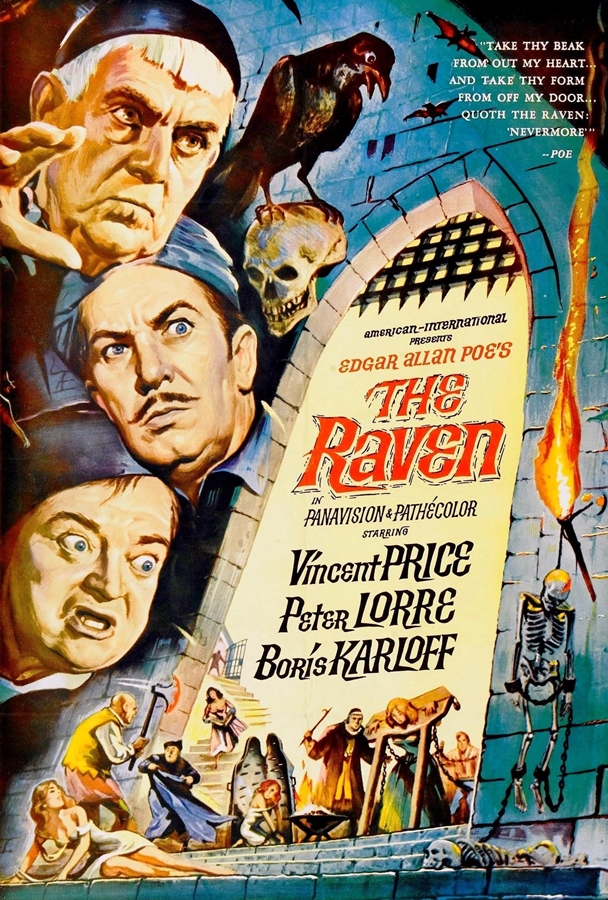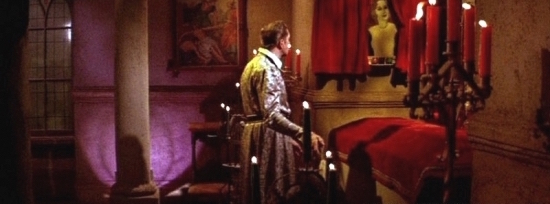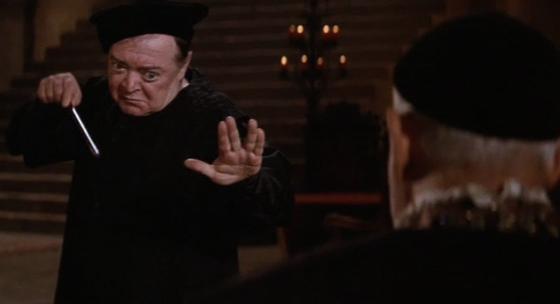
by Rosemary Benton
I feel sorry for those who rely entirely on the words of critics to determine whether or not a film is worth seeing. It's so easy to miss out of some of the most absurd and fun movies out there if the viewer approaches them with too analytical a mindset. For instance, those who read The New York Time's review of The Comedy of Terror really missed out on the humor of seeing the iconic actors of horror from the 30s and 40s satirize their own legacies.

In anticipation of the June 24th release of Roger Corman's new movie, The Masque of the Red Death, I dared to take a look at an advanced review of the film from Variety Magazine. Since seeing the film after its premier in Los Angeles, I can sympathize with some of the negative points in the above mentioned article, but it still annoys me that there will be people who will avoid this new Edgar Allan Poe tribute film simply because the Variety review and others seem to be approaching it with a lukewarm reception. Yes, The Masque of the Red Death has its faults, but for a horror movie that takes itself seriously in a time when classic horror themes have become passé, this is a very competently done and memorable movie.

Prince Prospero (Vincent Price) is a malicious yet pragmatic and cuttingly frank man whose province in medieval Italy has all but succumbed to the fictitious disease, the Red Death. Although a proud and evangelical self proclaimed Satanist, the Prince is able to rationalize his beliefs in Satan as an all powerful living God by drawing direct inspiration from the morally dubious nature of humanity and the ever present suffering of the world. Taking a woman named Francesca (Jane Asher) from one of the nearby villages after she pleads for the life of her fiancé and father, Prince Prospero makes it his mission to convert her from a believer in God to a hand maiden of Satan, and consequently a hand maiden to himself as a sort of high priest to Satan.

His harsh lessons ultimately culminate in a grand celebration at his palace where his “friends” and followers within the Italian aristocracy plan to feast and revel in a masquerade. All must dress in any human like garb they wish, but per his orders none are allowed to wear red. When a lone figure arrives in towering red robes, Prince Prospero angrily pursues him. The intruder is nothing that he expected, however, and bears a message that he is horrified to hear.

Roger Corman has drawn inspiration from the dark elegance of Edgar Allan Poe's bibliography for years now. Since his production and direction of the 1960 gothic horror film House of Usher, Corman has had at least one Poe-themed film released every year, all of which have been financial successes, if not necessarily critically received. In The Masque of the Red Death Corman once again captures the grandiosity and bleak horror of Poe's writing with the aid of his favorite go-to villainous gentleman, Vincent Price.

The Masque of the Red Death is unique in Corman's work to date. In the 1950s the young and ambitious schlock producer gained a name for himself by churning out many of the low budget, drive-in titles that we grew up on – The Fast and the Furious (1954), Day the World Ended (1955), and Machine Gun Kelley (1958). Using his growing reputation as a Hollywood force who could corral the crew, shoot a film in as little as five days, and still present a profitable final product, Corman swiftly moved on to producing and directing.

His subject matter has included some very interesting forays into edgier territories within American film since the enforcement of the Hayes Code in 1934. Of particular note I would point to the agency of the female characters in The Wasp Woman (1959), the self-aware satire in A Bucket of Blood (1959), and the rage of white racists against school desegregation in The Intruder (1962). In The Masque of the Red Death the topics of the film's plot are not so much unique as they are distinct for being so well interwoven.
The screenplay is credited to Twilight Zone writer Charles Beaumont and R. Wright Campbell (who wrote the screenplay for the 1957 film Man of A Thousand Faces). Their combined effort added an immense amount of humanity and depth to the original sparseness of Poe’s writing. Although the title clearly states that the movie is an adaptation of Poe's 1842 short story "The Mask of the Red Death: A Fantasy", the film is actually a merger of “Mask” with another Poe short story from 1849 titled, "Hop-Frog; Or, the Eight Chained Ourangoutangs". Given that the story of “Mask” is so sparse in characters outside of the protagonist Prince Prospero and the plague personification in The Red Death, the film was obviously in need of other characters to flesh it out into a feature film. The end result penned by Beaumont and Campbell is so perfect that it could easily be believed that the two stories were originally written as one.

The visuals in Corman’s Poe movies are likewise a stark departure from the static and clunky cinematography of his 1950s productions. Working with cinematographer Nicolas Roag (best known for his work on David Lean's 1962 film Lawrence of Arabia), The Masque of the Red Death kept the sharp colors and excellent sets of Corman’s earlier Poe movies. Roag's artistic eye brought it above and beyond that, however. The movement of the camera and the actors achieves a flowing and poetic feel that is new to Corman’s movies. The scene of The Red Death gliding through the revelers at the climax of the film is particularly gripping, as is the creative decision to have the end credits consist of a red and black dichromatic color scheme with the credits appearing in white around slowly placed tarot cards.

It’s a pleasure to see that as Roger Corman gains momentum in the film world he is readily making use of the network of talent opening up to him. Meanwhile, those he has relied upon for previous projects, particularly Vincent Price and R. Wright Campbell, seem to be flourishing under his more experienced directorship and heavier production budgets. My final thought on the film is that as a long time fan of Vincent Price I was thrilled to see that the poor performance I witnessed from Price in The Last Man on Earth was not indicative of a downward spiral for him. While he looked old and brittle in his role as Dr. Robert Morgan – a lonely, despondent, and disillusioned scientist – Price sprang to full vibrant life in a role that really allowed him to channel his inner devil – that of a swarthy, learned, arrogant, pompous and cruel classic villain. No matter what viewers might hear in the critical response to this film, it is a work that is absolutely worth the cost of admission. Of Corman's current bibliography this is a four and a half out of five stars. If Roger Corman continues to assemble and wield his creative team this well in his future projects then he is going to become a force to be reckoned with.
[Come join us at Portal 55, Galactic Journey's real-time lounge! Talk about your favorite SFF, chat with the Traveler and co., relax, sit a spell…]

![[June 24, 1964] Death Has No Master (Roger Corman's <i>The Masque of the Red Death</i>)](https://galacticjourney.org/wp-content/uploads/2019/06/masqueposter-672x372.jpg)








